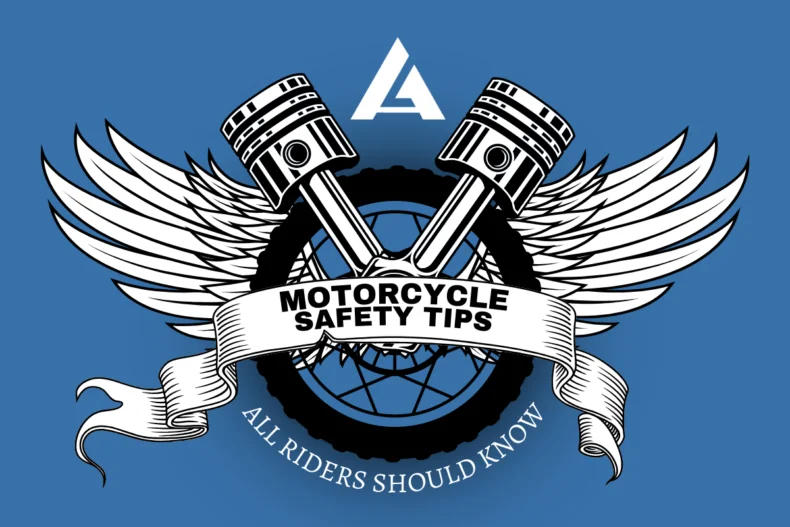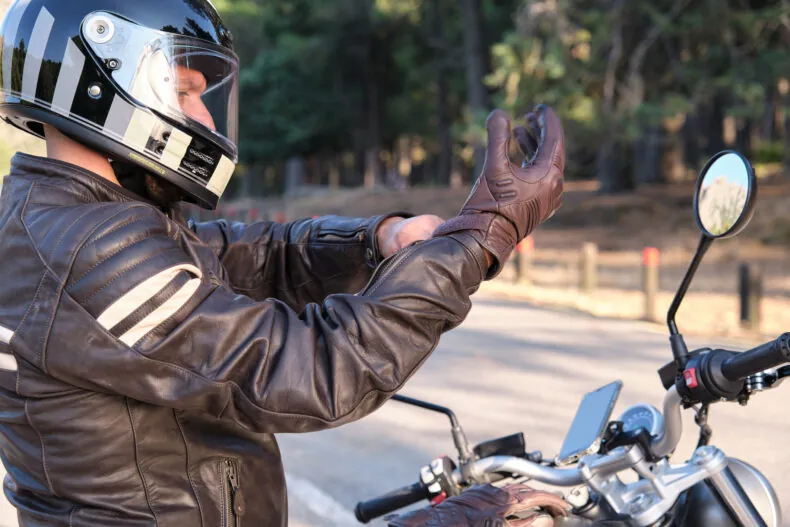Motorcycle Safety Tips All Riders Should Know
Motorcycle riding is an exhilarating and convenient way to get around, but it can also be dangerous. Motorcyclists account for 14% of all traffic fatalities even though motorcycles only make up 3% of all registered vehicles in the United States. Bikers are more susceptible to injury than passenger vehicle occupants. Therefore, it’s essential for all motorcycle riders to be mindful of general riding safety and to practice safe riding habits. Here are some important motorcycle safety tips all bikers should know:
Gear Up for Safety
Motorcycle riders should always gear up for safety by wearing the appropriate protective gear. Motorcycle gear provides essential protection in case of an accident or a fall.
- Always Wear a Helmet: A motorcycle helmet is the single most important piece of safety gear for a motorcycle rider. Wearing a helmet reduces the risk of head injuries, which are the leading cause of death in motorcycle accidents.
- Wear Eye Protection: Eye protection can shield your eyes from wind, dust, pollen, insects, and debris. It can also protect your eyes from small objects and rocks that may get kicked up by other vehicles or the wind.
- Wear Gloves: Gloves with reinforced materials, such as leather or abrasion-resistant textiles, offer a layer of protection against road rash, cuts, and impact injuries. Gloves also help the biker maintain a firm grip on the handlebars, which can help prevent slipping.
- Wear Long Pants and a Long-Sleeved Shirt: Long pants and a long-sleeved shirt made with abrasion-resistant materials can protect bikers from road rash and other injuries. Pants with built-in padding or armor around the knees and hips can also absorb impact and reduce the risk of injury. Look for leather pants with CE-certified armor for optimal impact protection.
- Wear a Leather Jacket: It’s best to wear a leather, textile, or reinforced jacket. Look for materials that provide abrasion resistance. The appropriate gear can help protect the rider’s skin in case of a fall or crash.
- Wear Boots: Motorcycle boots can protect your feet and ankles from injury because they are made to withstand impact, abrasion, and crushing forces. They often have built-in toe caps, heel cups, and ankle support to help minimize the risk of sustaining injuries in a crash.
- Carry a Basic First Aid Kit: In the event of an accident, carrying a first aid kit allows bikers to manage minor injuries or stabilize more serious ones until medical help arrives. It also empowers bikers to become self-sufficient in dealing with injuries in remote or less accessible areas where medical assistance may not be readily available.
Inspect Your Bike Before Each Ride
Before each ride, it’s best to inspect your bike for any problems. Regular bike inspections help identify any potential mechanical problems that could compromise safety. It’s important to check the tire pressure and tread wear and ensure the brakes are working properly. Also, inspect the lights, mirrors, and signals for functionality and ensure that all fluid levels are accurate. By conducting these pre-ride checks, riders can address any problems before they become hazardous.
Always Wear a Full-Face Helmet
A full-face helmet provides the highest level of protection for your head and face, including your chin. It should be a DOT-approved helmet that fits snugly, but not too tightly. Motorcycle helmets help protect against head injuries, facial trauma, and road debris, like rocks, insects, or dust. Wearing a full-face helmet also reduces wind noise and can help protect hearing. Motorcycle helmets are estimated to be 37% effective in preventing motorcycle rider deaths. Additionally, helmets are 41% effective in preventing motorcycle passenger deaths.
Check the Forecast Before Going Out
Before you go out for a motorcycle ride, check the forecast and dress appropriately for the weather. Weather conditions can significantly impact the roadways and visibility, making riding more challenging and dangerous.
Rain, ice, snow, fog, or strong winds can create slippery roads and reduce traction, increasing the risk of accidents. By being aware of the forecast, bikers can avoid adverse weather or take extra precautions when riding in challenging weather conditions.
Be Aware of Your Surroundings
When you’re riding, pay close attention to other vehicles, pedestrians, and cyclists. It’s vital for bikers to anticipate and respond to potential hazards effectively. Motorcycles are smaller and less visible than other vehicles, making it crucial to constantly scan the road and monitor the movement of other vehicles.
By actively observing the traffic, riders can identify potential hazards such as opening car doors or sudden stops. Highway safety is also crucial because of faster traveling speeds. When riders have less time to react or find an escape route, it can lead to a serious accident.
Be Visible and Predictable
Ensure you are highly visible to other drivers. Motorcycles can be difficult to see, especially in blind spots or during low-light conditions. To increase visibility, riders should wear bright clothing and reflective gear, use their headlights at all times, and position themselves strategically on the road to maximize visibility to other drivers.
It’s important for bikers to signal their intentions clearly, maintain a consistent speed, and follow traffic laws. It’s best to avoid weaving in and out of traffic or riding in a vehicle’s blind spots. Motorcycle riders can stay safe and help reduce the risk of collisions when they communicate their movements and ride safely.
Follow Traffic Rules and Use Your Signals
Traffic laws are enforced to promote safety on the roads. By following traffic laws, bikers can minimize the risk of crashes.
It’s important to use signals when you are changing lanes, making turns, or stopping. This way, others can anticipate the rider’s intentions, reducing the chances of motorcycle wrecks. When motorcyclists follow traffic rules and consistently use signals, they demonstrate responsible and safe riding behavior, protecting themselves and others on the road.
Stay at a Safe Distance
Motorcycles have shorter stopping distances than motor vehicles, and being too close to the vehicle in front can result in rear-end collisions. It is recommended to keep a riding distance of at least two seconds, allowing sufficient time to react to sudden stops or changes in traffic. This will give you time to react if the driver in front of you brakes suddenly.
By maintaining a safe riding space from other vehicles, motorcycle riders create a buffer zone that enhances their safety and visibility, reducing the likelihood of crashes.
Maintain a Safe Speed
Speeding is a major factor in motorcycle crashes. Speeding reduces the time a biker has to react to unexpected situations. Additionally, speeding significantly increases the severity of injuries sustained in a crash. Riding too fast can also make it difficult to navigate turns, maintain control of the motorcycle, or respond to dangers.
Take a Safety Course or an Advanced Riding Course
Bikers can take a motorcycle safety course to learn the skills they need to ride safely. There are many different courses available, including basic courses and advanced courses. Enrolling in a safety course or an advanced riding course is highly beneficial, especially for new riders.
Safety courses cover topics such as defensive riding strategies, emergency braking, and proper cornering techniques. Advanced riding courses focus on honing skills and techniques for challenging road conditions and increasing overall riding proficiency.
Watch for Road Hazards
Look out for road hazards, such as potholes, oil, debris, gravel, and sand. These kinds of hazards can cause you to lose traction and control of your motorcycle. Additionally, being aware of roadway conditions, pedestrians, construction, and wildlife crossings allows riders to make informed decisions and adjust their riding accordingly to avoid potential collisions. Riders should scan the road ahead, especially in curves or intersections, and adjust their riding accordingly.
Select the Right Bike
Choosing the right motorcycle is a substantial decision for all riders. Each motorcycle has different characteristics, handling capabilities, and power levels. It is crucial to select a bike that suits the rider’s size, skill level, and intended use. A motorcycle that is too powerful or difficult to handle can increase the risk of accidents, especially for inexperienced riders.
Conversely, a bike that is too small or lacks the necessary power for highway speeds may compromise safety in certain situations. Selecting the right bike ensures optimal control and comfort, enhancing the overall safety and enjoyment of the riding experience.
Ride According to Your Skills and Ability
Bikers should always ride in accordance with their skills and abilities. Pushing beyond one’s comfort zone or attempting advanced maneuvers without proper training can result in serious injuries. Riders should be mindful of their own limitations and gradually develop their skills through practice and experience.
Contact Alpha Accident Lawyers if You Were Injured in a Motorcycle Accident
Ride safe and follow these safety tips to help reduce the risk of being in a motorcycle crash. Motorcycle accidents often result in severe injuries and extensive costs, including medical expenses, lost wages, and emotional distress.
If you have been injured in a motorcycle accident, you should contact Alpha Accident Lawyers as soon as possible. We will fight for your legal rights and help you obtain fair compensation. We have a proven track record of success and have helped many injured victims get the compensation they need to recover from their injuries and losses.
Don’t face the aftermath of a motorcycle accident alone. Our personal injury law firm offers a free initial consultation, so there is no risk in consulting our motorcycle accident lawyers. Call us today to schedule a free case evaluation.
START YOUR FREE CONSULTATION







